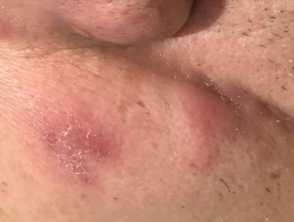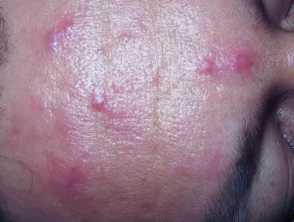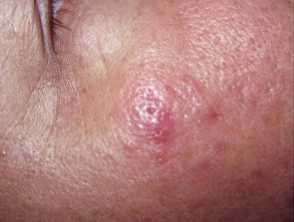What is neutrophilic sebaceous adenitis?
Neutrophilic sebaceous adenitis is a rare inflammatory dermatosis that most commonly affects the face and torso of young men.
It is a form of sebaceous adenitis and is characterised by annular or arcuate plaques on the face and trunk, which on biopsy show a mononuclear infiltrate around blood vessels and follicles, in addition to revealing several necrotic sebocytes accompanied by neutrophils. Similar histological findings may be seen in a rare painful vulval papular eruption.
Who gets neutrophilic sebaceous adenitis?
This is a rare condition described in less than 15 individuals. Most were young men; only a few cases were described in women.
What causes neutrophilic sebaceous adenitis?
The cause is unknown, though a few of the facial cases may have been exacerbated by light exposure. In one case report, there was close association with Demodex mites adjacent to the adenitis.
What are the clinical features of neutrophilic sebaceous adenitis?
The facial rash is characterised by acute and recurrent erythematous annular or arcuate oedematous plaques on the cheeks, forehead and torso. Some cases appear to be exacerbated annually by summertime light exposure and in the acute stages, occasional pustules may be seen.
Rarely, similar histological findings are seen presenting as tender papular cyst-like lesions on the vulva in women.
How do clinical features vary in differing types of skin?
Erythema may be less evident in skin of colour.
What are the complications of neutrophilic sebaceous adenitis?
There are usually no systemic symptoms associated with this dermatosis, only a single case had associated fever, joint pain, and lymphadenopathy.
How is neutrophilic sebaceous adenitis diagnosed?
A clinical suspicion needs to be corroborated by skin biopsy which demonstrates focal necrosis of sebocytes surrounded by neutrophils and a mononuclear infiltrate surrounding superficial blood vessels and hair follicles.
What is the differential diagnosis for neutrophilic sebaceous adenitis?
- Acne
- Rosacea
- Cutaneous lupus erythematosus
- Acute febrile neutrophilic dermatosis/Sweet syndrome
- Jessner lymphocytic infiltrate
The genital lesions in women may be confused with:
What is the treatment for neutrophilic sebaceous adenitis?
Several agents have been advocated, none with reproducible or reliable effect, including:
- Sunscreens
- Topical steroids
- Topical calcineurin inhibitors
- Oral steroids
- Tetracycline antibiotics
- Dapsone
- Isotretinoin.
Vulval neutrophilic sebaceous adenitis may respond to:
- Hormonal therapies — spironolactone and ethinyl oesdrodiol/cyproterone acetate
- Topical antibiotics like clindamycin
- Oral tetracyclines.
How do you prevent neutrophilic sebaceous adenitis?
There is no known way of preventing neutrophilic sebaceous adenitis; those cases exacerbated by light may be prevented by photoprotection.
What is the outcome for neutrophilic sebaceous adenitis?
To date, all cases have undergone eventual spontaneous resolution within 3-4 years.


